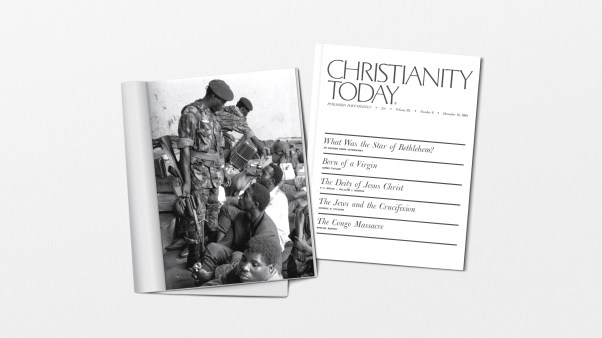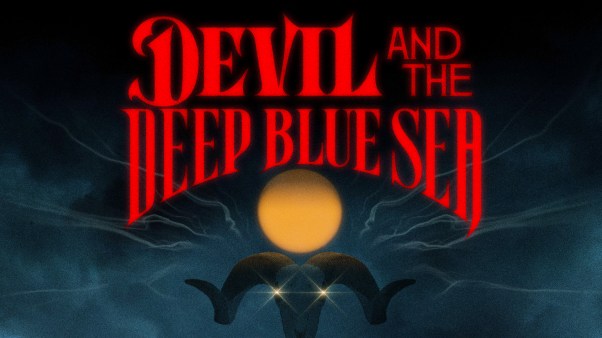Often, the most moving moments of the Olympic Games are when athletes climb onto the podium to receive their gold medals as their country’s anthem plays. When Hidilyn Diaz won the women’s 55-kilogram class in weightlifting at the Tokyo Olympics in July 2021, it was the Philippines’ first-ever gold medal in any sport. Tears flowed down her cheeks as she heard her country’s national anthem, “Lupang Hinirang,” play for the first time at the Olympics.
The pageantry around today’s Olympic award ceremonies are a 20th-century invention. The Olympic podium debuted at the Lake Placid Olympic Winter Games in 1932, and the tradition of raising the flags as the champion’s national anthem plays began at the Summer Olympic Games later that year in Los Angeles.
As the Paris Olympics progresses and national anthems sound in living rooms around the world, CT has put together short explainers of five anthems full of Christian references and themes. While the most well-known Christian anthem in the world—and the oldest—is the UK’s “God Save the King,” little is known about its origins, so we instead featured anthems from New Zealand, Suriname, Peru, St. Kitts and Nevis, and South Africa.
“God Defend New Zealand”
God of Nations at Thy feet, In the bonds of love we meet, Hear our voices, we entreat, God defend our free land. Guard Pacific's triple star From the shafts of strife and war, Make her praises heard afar, God defend New Zealand.
The New Zealand Saturday Advertiser published Irish journalist Thomas Bracken’s five-stanza poem “God Defend New Zealand” in 1876. Declaring it a new national hymn, the newspaper asked readers to send in music to accompany the poem for a prize, and Catholic teacher John Joseph Woods submitted the winning score. Two years later, it was translated into the indigenous language of Māori and titled “Aotearoa,” which is Māori for “New Zealand.”
At the time, the then-British colony’s anthem was “God Save the King,” and it wasn’t until 1940 that the government purchased the rights to Bracken’s lyrics and Woods’s music. After a petition calling for it to become a national anthem garnered over 7,000 signatures in 1976, “God Defend New Zealand” was finally given equal footing with the royal anthem in 1977, making it one of New Zealand’s two national anthems.
Today, about nearly half of New Zealanders claim no religion, and while some have criticized the anthem for its religious focus, no concerted effort has been made to change it. Geoff Macpherson, principal of Grace Theological College in Auckland, believes this is because New Zealanders are reserved in their patriotism.
Meanwhile, among Christians, “most feel proud and happy that our anthem is so blatantly Christian,” Macpherson said. Will Warden, pastor of Tawa Baptist Church in Wellington, describes the anthem’s first verse as “an acknowledgment of God’s sovereignty. God isn’t just God of Israel or New Zealand, he is the God of all nations and cultures.”
Today, the anthem is usually sung first in Māori, then in English. Macpherson believes the Māori translation has endeared the anthem to Kiwis: “Anything in the indigenous language of a people brings it closer to their hearts.”
“God Be with Our Suriname”
God be with our Suriname May He elevate our lovely land How we came here together We are dedicated to its soil Working we keep in mind Justice and truth will set free All that is good to devote oneself to Will give value to our land
(Translated from Dutch)
A former Dutch colony, Suriname is the smallest country in South America and mostly covered by rainforests. Pastor Cornelis Atses Hoekstra initially penned “God Be with Our Suriname” in Dutch for his Sunday school class in 1893. Later, the poet Henri Frans de Ziel translated the lyrics into Suriname’s native language of Sranan Tongo. The government officially adopted it as the national anthem in December 1959.
Similar to the experience of its neighbors—French Guiana to the east, and Guyana to the west—Suriname first heard the gospel through their Dutch colonizers. Today, about half of the country’s population identifies as Christian.
Yet the Dutch also brought enslaved Africans to the country. Some Surinamese take issue with the Christian themes of the anthem because of these historic ties to colonialism and slavery. Gerno Odang, a speaker and visual artist who promotes Afro-Surinamese culture, noted that, while he respects other religions, “Christianity was used as a tool to enslave people before and during the slave trade and even afterward,” pointing to the experience of the Maroons, descendants of Africans in the Americas who fled plantation slavery.
Rebrouf Sanvisi, worship leader at Christ Embassy Suriname church in the capital of Paramaribo, said that whenever Christians like him sing the anthem, it gives them a “sense of hope, trust, and confidence, knowing that the highest power in the universe is standing with us.”
“And if he is with us, who or what can be against us?” he adds, referring to Romans 8:31.
“O Land of Beauty!” (Saint Kitts and Nevis)
O Land of Beauty! Our country where peace abounds, Thy children stand free On the strength of will and love. With God in all our struggles, Saint Kitts and Nevis be, A nation bound together, With a common destiny.
In early 1983, the Federation of St. Kitts and Nevis, an island nation in the eastern Caribbean, held a competition to select a national anthem months before it attained full independence from the UK.
Artist and musician Kenrick Georges decided to write and compose an entry at 2 a.m. on the day of the deadline—March 31—and completed it at 6 a.m., according to local media. An hour later, he asked a piano teacher to play it for him, and he submitted a recording of the song on a cassette tape later that day.
The subcommittee for the competition chose his song, noting that it would “stand the test of time,” and in September, it became the national anthem. In a tribute to Georges, who died in 2019, former prime minister Timothy Harrison called the song a “deeply moving and magnificent ode to the country’s beauty and tranquility.”
About 75 percent of the country’s small population of around 50,000 identify as Christian, as the British brought the gospel with them as they settled in the country in 1624. The St. Kitts Evangelical Association is a founding member of the Evangelical Association of the Caribbean, which represents five million evangelicals in the region.
“Himno Nacional del Perú”
We are free! May we always be so, may we always be so! And may the Sun renounce its light, its light, its light, Before we break the solemn vow that the Fatherland lifted up to the Eternal, Before we break the solemn vow that the Fatherland lifted up to the Eternal. (Translated from Spanish)
In August 1821, following Peru’s declaration of independence from Spain, the country’s Argentinian liberator José de San Martin invited the general public to send in submissions for Peru’s national anthem. As the new government was bankrupt at the time, it could only offer the country’s gratitude as a prize.
A young Dominican friar, José Bernardo Alcedo, who had written hymns for Mass, submitted two compositions, with the lyrics written by his lawyer friend José de la Torre Ugarte. Alcedo was amongst the finalists, and he presented both compositions to San Martin. After hearing the melody of the second song, San Martin said, “Without a doubt, this is the national anthem.”
The explicit mention of God in the lyrics can be found in its final stanza. The English translation of its last line reads, “Let’s renew the great oath that we rendered to the God of Jacob.” While there have been many attempts to change the wording of the original anthem, the issue has been the song’s emphasis on the Peruvian struggle for freedom, rather than its mention of God, as about 76 percent of Peru’s population is Catholic.
National Anthem of South Africa (South Africa)
Lord bless Africa May her glory be lifted high Hear our petitions Lord bless us, your children
(Translated from Xhoso and Zulu)
One of only three anthems in the world that start in one key and end in another, the South African national anthem fuses together two songs: the Xhosa hymn “Nkosi Sikelel’ iAfrika” (God Bless Africa) and the Afrikaans song “Die Stem van Suid-Afrika” (The Call of South Africa). The anthem, which also incorporates five South African languages, signifies a call to unity after the end of apartheid.
Enoch Mankayi Sontonga, a Xhosa teacher and choirmater at a Methodist mission school, composed “Nkosi Sikelel’ iAfrika” in 1897 as a school anthem. The song, which reflects both Methodist hymnody and African praise singing, was first performed publicly in 1899 at the ordination of John Hlengani Mboweni, the first Tsonga Methodist pastor.
The song gained popularity as it was sung to close the 1912 meeting of the South African Native National Congress (now the African National Congress), the liberation movement seeking to advance the rights of black South Africans. The congress adopted the song as its official anthem in 1925, causing it to be banned during apartheid.
Meanwhile, poet C. J. Langenhoven wrote “Die Stem van Suid-Afrika” in 1918, and three years later, Dutch Reformed pastor Marthinus Lourens de Villiers composed its melody. It became the national anthem in 1938, alongside “God Save the King.”
In 1994, before Nelson Mandela’s inauguration as president, State President F. W. de Klerk declared that both songs would be the country’s national anthems. Three years into his administration, Mandela declared a new official national anthem that combined shortened versions of both songs.
“The declaration of trust [in God] is the first and most important component of the South African National Anthem,” wrote Morakeng E. K. Lebaka, an African musical arts researcher at the University of South Africa. “The second element … is the invitation to trust and to unite, addressed to the community (South Africans).”
Four other African countries have historically adopted Sontonga’s “Nkosi Sikelel’ iAfrika” as their national anthem: Zambia, Tanzania, Namibia, and Zimbabwe. Zambia and Tanzania still use the melody for their anthems.












